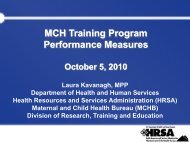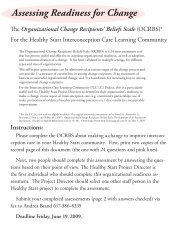60 performance measures with operational definitions (PDF) - HRSA
60 performance measures with operational definitions (PDF) - HRSA
60 performance measures with operational definitions (PDF) - HRSA
You also want an ePaper? Increase the reach of your titles
YUMPU automatically turns print PDFs into web optimized ePapers that Google loves.
# Measure Numerator Denominator IOM Quality Donabedian Diagnosis Measure Required Data Elements Notes /Reference<br />
Domain Framework Category Level*<br />
* (A)Individual Clinician or Group of Clinicians (e.g. nurses, residents, attendings, fellows); (B) Facility (ED); (C) System-Wide Measure<br />
Initial Care for Every Emergency Department Patient<br />
1.1 Measuring weight in Number of visits by patients
# Measure Numerator Denominator IOM Quality Donabedian Diagnosis Measure Required Data Elements Notes /Reference<br />
Domain Framework Category Level*<br />
* (A)Individual Clinician or Group of Clinicians (e.g. nurses, residents, attendings, fellows); (B) Facility (ED); (C) System-Wide Measure<br />
Emergency Department Infrastructure and Personnel<br />
2.1 Physician/Advanced Total number of physician/Advanced Number of visits Effective, Process General B Unique visit identifier<br />
Practice Nurse staff Practice Nurse hours of staffing per week. per week.<br />
Safe,<br />
CPT evaluation and<br />
hours per<br />
Weight hours:<br />
Weight each visit by Efficient<br />
management code<br />
presentational case Each Licensed Independent Practitioner hour CPT code:<br />
MD staffing hours<br />
mix<br />
= 1<br />
99285 = 5 points<br />
Each trainee hour = 0.5<br />
99284 = 4 points<br />
99283 = 3 points<br />
99282 = 2 points<br />
99281 = 1 point<br />
Critical care = 5<br />
points/30 minutes<br />
2.2 Nursing Staff Hours The formula utilizes the following six factors, N/A Effective, Process General B Unique visit identifier -Based upon ENA staffing guideline formula<br />
per presentational case<br />
mix<br />
which form the basis for determining<br />
appropriate staffing requirements: (1) patient<br />
Safe,<br />
Efficient<br />
CPT evaluation and<br />
management code<br />
-Compare calculated (or expected) nursing FTEs per year<br />
<strong>with</strong> actual nursing FTEs for the same year<br />
census (# of patients for each facility level);<br />
RN staffing hours<br />
(2) patient acuity (facility level CPT code); (3)<br />
RN paid time off hours<br />
patient length of stay (again for acuity level);<br />
RN paid educational<br />
(4) nursing time for nursing interventions and<br />
activities by patient acuity; (5) skill mix for<br />
providing patient care based on nursing<br />
interventions that can be delegated to a nonregistered<br />
nurse; and (6) an adjustment factor<br />
for the non-patient care time included in each<br />
FTE. To generate an adjustment factor, data<br />
on total # of hours of Paid Benefit Time for<br />
all RNs over 12 months, Annual Average<br />
Number of Paid Educational Hours for one<br />
RN, and Total # of paid hours for all RNs<br />
(12 months) are needed.<br />
hours per year<br />
2.3 Pediatric equipment in Presence of all necessary equipment for the N/A Effective, Structure General B -Drawn from “Policy Statement—Guidelines for Care of<br />
the ED<br />
care of pediatric patients as defined by<br />
AAP/ACEP (100% of all recommended<br />
equipment); report as Yes or No<br />
Safe<br />
Children in the Emergency Department”; Annals of<br />
Emergency Medicine and Pediatrics, October 2009:<br />
APPENDIX 2:<br />
2.4 Ongoing assessment Policy in place for continued assessment of N/A<br />
Effective, Process General A, B -From ACEP/AAP: Joint Policy Statement Guidelines for<br />
of pediatric<br />
competencies for<br />
physician and nursing<br />
staff<br />
pediatric provider competency (Y/N)<br />
Safe<br />
Care of Children in the Emergency Department. Pediatrics,<br />
9/22/09<br />
-Baseline and periodic competency evaluations completed<br />
for all ED clinical staff, including physicians, are age specific<br />
and include evaluation of skills related to neonates, infants,<br />
children, adolescents, and children <strong>with</strong> special health care<br />
needs.<br />
-Competencies are determined by each institution’s medical<br />
staff privileges policy.<br />
2 of 16
# Measure Numerator Denominator IOM Quality Donabedian Diagnosis Measure Required Data Elements Notes /Reference<br />
Domain Framework Category Level*<br />
* (A)Individual Clinician or Group of Clinicians (e.g. nurses, residents, attendings, fellows); (B) Facility (ED); (C) System-Wide Measure<br />
Emergency Department Infrastructure and Personnel<br />
2.5 Physician Board Number of physician staff certified in Total number of Effective, Structure General A, B Number of MD on staff<br />
Certification<br />
Emergency Medicine (ABEM) or Pediatric physicians on staff Safe<br />
Number of MD certified<br />
Emergency Medicine (ABEM or ABP)<br />
in EM or pediatric EM<br />
2.6 Continuing Education Total # CME/CEU credits annually related Total number of Effective, Process General A, B Number of staff<br />
in pediatric emergency to pediatric emergency topics for all<br />
physicians, Safe<br />
(MD/RN)<br />
topics<br />
physicians, advanced practice and staff nurses advanced practice<br />
Total number of CME/<br />
and staff nurses<br />
CEU credits related to<br />
pediatric EM<br />
2.7 Pediatric<br />
Number of physicians, advanced practice Total number of Effective, Process General A, B Number of staff<br />
competencies and nurses and staff nurses who participate in physicians, Safe<br />
(MD/RN)<br />
simulation training teamwork training in a simulated<br />
advanced practice<br />
Number of staff<br />
environment involving pediatric topics each and staff nurses<br />
participating in<br />
year<br />
simulations<br />
2.8 Presence of on-site a. Presence of a physician pediatric N/A Effective, Structure General B -Definitions of coordinators drawn from “Policy<br />
pediatric<br />
coordinator(s) b.<br />
c.<br />
coordinator<br />
Presence of a nurse pediatric coordinator<br />
Presence of both a physician and a nurse<br />
pediatric coordinator<br />
Safe, Patient-<br />
Centered<br />
Statement—Guidelines for Care of Children in the<br />
Emergency Department”: Annals of EM and Pediatrics,<br />
October 2009:<br />
3 of 16
# Measure Numerator Denominator IOM Quality Donabedian Diagnosis Measure Required Data Elements Notes /Reference<br />
Domain Framework Category Level*<br />
* (A)Individual Clinician or Group of Clinicians (e.g. nurses, residents, attendings, fellows); (B) Facility (ED); (C) System-Wide Measure<br />
Patient-Centered Emergency Department Care<br />
3.1 Parent/caregiver a. Number of parents/caregivers reporting Number of Effective, Process General A, B Unique visit identifier Use the following questions:<br />
understanding of<br />
discharge instructions<br />
b.<br />
c.<br />
“not at all” difficult to understand what<br />
they have to do to take care of their<br />
child’s medical problem after discharge<br />
Number of parents/caregivers reporting<br />
“not at all” difficult to understand which<br />
symptoms or changes should cause them<br />
to return <strong>with</strong> their child.<br />
Number of parent/caregivers reporting<br />
parents/caregivers<br />
surveyed<br />
Safe, Patient-<br />
Centered<br />
Patient disposition<br />
Patients/ families<br />
surveyed<br />
a. How difficult was it for you to understand what you<br />
have to do to take care of your child’s medical<br />
problem?<br />
b. How difficult was it for you to understand which<br />
symptoms or changes should cause your child to<br />
return to the emergency department?<br />
Scale- not at all difficult; a little difficult; moderately<br />
difficult; quite a bit difficult; extremely difficult<br />
-Discharge instructions include all verbal and written<br />
“not at all” difficult to both questions<br />
communications<br />
-Off-site survey - phone, mail, email all acceptable<br />
-Time frame – 48 hours to 6 weeks after the ED visit; can<br />
be administered <strong>with</strong> other satisfaction questions<br />
3.2 Use of interpreter Number of visits by patients
# Measure Numerator Denominator IOM Quality Donabedian Diagnosis Measure Required Data Elements Notes /Reference<br />
Domain Framework Category Level*<br />
* (A)Individual Clinician or Group of Clinicians (e.g. nurses, residents, attendings, fellows); (B) Facility (ED); (C) System-Wide Measure<br />
Patient-Centered Emergency Department Care<br />
3.5 Patient-centered care Presence of a patient-centered care advisory N/A<br />
Patient- Structure General B Purpose/Roles of Family Advisory Council:<br />
advisory council council that addresses care AND includes<br />
family members (Y/N)<br />
Centered<br />
-Provides a venue for patients and families to provide input<br />
into policy and program development<br />
-Channels information, needs, and concerns to staff and<br />
administration<br />
-Actively helps implement changes<br />
-Provides a safe venue for patients and family to provide<br />
input in a setting where they are receiving care.<br />
Reference at::<br />
http://www.ipfcc.org/advance/Advisory_Councils.pdf<br />
3.6 Patient and family Number of parents/caregivers reporting "yes, Number of Patient- Process General A, B Use the following question from the HCAHPS survey:<br />
participation in<br />
medical decision<br />
making<br />
definitely" to participation in medical<br />
decision-making<br />
parents/caregivers<br />
surveyed<br />
Centered<br />
“Were you involved in decisions about your child’s care<br />
and treatment as much as you wanted?"<br />
Scale - yes definitely; yes somewhat; no<br />
-Off-site survey (phone, mail, email) all acceptable<br />
-Exact question must be used. It may be added to existing<br />
survey mechanism.<br />
-Time frame – 48 hours to 6 weeks after the ED visit; can<br />
be administered <strong>with</strong> other satisfaction questions<br />
5 of 16
# Measure Numerator Denominator IOM Quality Donabedian Diagnosis Measure Required Data Elements Notes /Reference<br />
Domain Framework Category Level*<br />
* (A)Individual Clinician or Group of Clinicians (e.g. nurses, residents, attendings, fellows); (B) Facility (ED); (C) System-Wide Measure<br />
Emergency Department Flow<br />
4.1 Door to Provider Time interval between patient presentation Include all visits by Timely, Outcome General B, C Unique visit identifier -This measure has the same <strong>operational</strong> definition as the<br />
and the first time the patient is seen by a<br />
provider, excluding triage personnel, who can<br />
initiate a diagnostic evaluation or<br />
therapeutic plan for all patients
# Measure Numerator Denominator IOM Quality Donabedian Diagnosis Measure Required Data Elements Notes /Reference<br />
Domain Framework Category Level*<br />
* (A)Individual Clinician or Group of Clinicians (e.g. nurses, residents, attendings, fellows); (B) Facility (ED); (C) System-Wide Measure<br />
Emergency Department Flow<br />
4.6 Plain film imaging Time interval between plain film order and<br />
Timely Outcome Cross-cutting B Unique visit identifier -Include all plain films performed on patients < 18 years of<br />
turnaround time: time<br />
to image available to<br />
image available for viewing by ED staff<br />
(diagnostic test)<br />
Test order time<br />
Test complete time<br />
age<br />
-Report as median time in minutes<br />
ED staff<br />
Test name/type<br />
7 of 16
# Measure Numerator Denominator IOM Quality Donabedian Diagnosis Measure Required Data Elements Notes /Reference<br />
Domain Framework Category Level*<br />
* (A)Individual Clinician or Group of Clinicians (e.g. nurses, residents, attendings, fellows); (B) Facility (ED); (C) System-Wide Measure<br />
Pain and Sedation<br />
5.1 Topical anesthetics for Number of face or scalp lacerations receiving Number of facial or Effective, Process Cross-cutting A, B Unique visit identifier<br />
pediatric laceration topical anesthesia prior to suture or staple scalp lacerations Patient-<br />
(pain),<br />
Medication name<br />
repair<br />
repair in patients < 18 years of age<br />
undergoing suture Centered<br />
lacerations<br />
CPT code (for<br />
or staple repair in<br />
suture/staple procedure)<br />
patients < 18 years<br />
ICD-9 code (identifies<br />
of age<br />
laceration patients)<br />
5.2 Effective pediatric Number of patients < 18 years of age Number of Effective, Process Cross-cutting A, B All of the following criteria must be present for a sedation<br />
procedural sedation meeting criteria for effective procedural<br />
sedation<br />
procedural<br />
sedations<br />
performed in<br />
patients < 18 years<br />
of age<br />
Patient-<br />
Centered<br />
(pain)<br />
to be considered effective:<br />
a) The patient does not have unpleasant recall of the<br />
procedure.<br />
b) The patient did not experience sedation-related adverse<br />
events resulting in abandonment of the procedure or a<br />
permanent complication or an unplanned admission to the<br />
hospital or prolonged ED observation<br />
c) The patient did not actively resist or require physical<br />
restraint for completion of the procedure. The need for<br />
minimal redirection of movements should not be<br />
considered as active resistance or physical restraint.<br />
-Responses to these 3 criteria may be included as part of the<br />
ED procedural sedation record.<br />
Reference: Roback et al. (2009). Consensus-Based<br />
Recommendations for Standardizing Terminology and<br />
Reporting Adverse Events for Emergency Department<br />
Procedural Sedation and Analgesia in Children. Annals of<br />
Emer. Med:53(4)<br />
5.3 Documenting age Number of patients < 18 years of age <strong>with</strong> Number of patients Effective, Outcome Cross-cutting A, B Unique visit identifier -Examples of age appropriate pain scores include; NPASS,<br />
appropriate pain<br />
scores<br />
an age appropriate pain score documented < 18 years of age<br />
presenting to the<br />
Patient-<br />
Centered<br />
(pain)<br />
Presence of pain y/n<br />
Type of pain scale used<br />
FLACC, Bieri faces pain scale and verbal analogue scale<br />
(VAS).<br />
who screen positive<br />
for pain<br />
Pain score<br />
5.4 Treating and Number of patients < 18 years of age <strong>with</strong> a Number of patients Effective, Process Cross-cutting A, B Unique visit identifier -Examples of age appropriate pain scores include; NPASS,<br />
reassessing pain pain intervention and reassessment <strong>with</strong>in 90<br />
minutes of initial age-appropriate positive<br />
< 18 years of age<br />
presenting to the<br />
Timely,<br />
Patient-<br />
(pain)<br />
Pain score<br />
Pain score assessed time<br />
FLACC, Bieri faces pain scale and verbal analogue scale<br />
(VAS).<br />
pain score<br />
who screen positive Centered<br />
Pain intervention<br />
for pain<br />
documented<br />
5.5 Reducing pain in Number of patients < 18 years of age <strong>with</strong> Number of patients Effective, Process Cross-cutting A, B Unique visit identifier -Examples of age appropriate pain scores include; NPASS,<br />
children <strong>with</strong> acute<br />
fractures<br />
pain assessed and reassessed using the same<br />
age-appropriate pain scale who show<br />
< 18 years of age<br />
<strong>with</strong> acute long-<br />
Timely,<br />
Patient-<br />
(pain), fractures<br />
ICD-9 code<br />
Pain score<br />
FLACC, Bieri faces pain scale and verbal analogue scale<br />
(VAS).<br />
documented improvement in pain score<br />
<strong>with</strong>in 90minutes of arrival<br />
bone fractures Centered<br />
Pain score assessed time<br />
8 of 16
# Measure Numerator Denominator IOM Quality Donabedian Diagnosis Measure Required Data Elements Notes /Reference<br />
Domain Framework Category Level*<br />
* (A)Individual Clinician or Group of Clinicians (e.g. nurses, residents, attendings, fellows); (B) Facility (ED); (C) System-Wide Measure<br />
Severe Illness<br />
6.1 Confirming<br />
Number of patients
# Measure Numerator Denominator IOM Quality Donabedian Diagnosis Measure Required Data Elements Notes /Reference<br />
Domain Framework Category Level*<br />
* (A)Individual Clinician or Group of Clinicians (e.g. nurses, residents, attendings, fellows); (B) Facility (ED); (C) System-Wide Measure<br />
Trauma<br />
7.1 Children <strong>with</strong> minor Number of patients
# Measure Numerator Denominator IOM Quality Donabedian Diagnosis Measure Required Data Elements Notes /Reference<br />
Domain Framework Category Level*<br />
* (A)Individual Clinician or Group of Clinicians (e.g. nurses, residents, attendings, fellows); (B) Facility (ED); (C) System-Wide Measure<br />
Respiratory Diseases<br />
8.1 Systemic<br />
Number of asthma patients 1<br />
Medication name<br />
inhaled B-agonist,<br />
ICD-9 code<br />
age >=2yrs and <<br />
18 years of age<br />
Medication receipt time<br />
8.2 Objective<br />
Number of patients whose objective asthma Number of patients Effective, Outcome Asthma A, B Unique visit identifier -Numerator value is 0 if only one or no asthma severity<br />
improvement in<br />
asthma severity score<br />
for patients <strong>with</strong> acute<br />
asthma exacerbations<br />
score at discharge is less than the asthma<br />
score at presentation<br />
<strong>with</strong> a diagnosis of<br />
asthma (493.xx,)<br />
treated <strong>with</strong> >1<br />
inhaled B-agonist,<br />
age >=2yrs and <<br />
18 years of age<br />
Patient-<br />
Centered<br />
Patient arrival time<br />
Patient left ED time<br />
Medication name<br />
ICD-9 code<br />
Medication receipt time<br />
Asthma severity score<br />
Asthma severity score<br />
time<br />
scores documented<br />
-Numerator value is 0 if discharge asthma severity score is<br />
greater than score at presentation<br />
Examples of objective asthma scores:<br />
1. Ducharme FM et al. (2008). The Pediatric Respiratory<br />
Assessment Measure: A valid clinical score assessing acute<br />
asthma severity from toddlers to teenagers. J Pediatr.<br />
152:476-80<br />
2. Gorelick MH et al. (2004). Performance of a novel<br />
clinical score, the pediatric asthma severity score (PASS), in<br />
the evaluation of acute asthma. Acad Emerg Med.11(1):10-<br />
18<br />
3. Smith SR et al. (2002). Validation of the pulmonary score:<br />
an asthma severity score for children. Acad Emerg Med.<br />
9(2):99-104<br />
8.3 Timeliness of inhaled Time from arrival to first inhaled B-agonist N/A Effective, Process Asthma A, B Unique visit identifier -Measure includes patients <strong>with</strong> a diagnosis of asthma<br />
B-agonist treatment<br />
for patients <strong>with</strong> acute<br />
asthma exacerbations<br />
administered<br />
Timely<br />
Patient arrival time<br />
Medication name<br />
ICD-9 code<br />
Medication receipt time<br />
(493.xx,) treated <strong>with</strong> >1 inhaled B-agonist, age >=2yrs<br />
-Inhaled B-agonists include albuterol and levalbuterol<br />
-Time of administration of inhaled treatment is measured<br />
(not time of order).<br />
8.4 Evidence based Presence of an evidence based guideline for N/A Effective, Structure Bronchiolitis B Reference at::<br />
guideline for<br />
bronchiolitis<br />
bronchiolitis treatment (Y/N)<br />
Efficient<br />
http://www.pediatrics.org/cgi/content/full/118/4/1774<br />
8.5 Systemic<br />
Number of croup patients < 18 years of age Number of patients Effective Process Croup A, B Unique visit identifier -Systemic corticosteroid includes IV, IM or oral<br />
corticosteroids in<br />
patients <strong>with</strong> croup<br />
given a systemic corticosteroid during visit < 18 years of age<br />
<strong>with</strong> a diagnosis of<br />
Patient arrival time<br />
Patient left ED time<br />
dexamethasone, oral prednisone, IV or IM<br />
methylprednisolone<br />
croup (464.4)<br />
Medication name<br />
Medication receipt time<br />
ICD-9 code<br />
11 of 16
# Measure Numerator Denominator IOM Quality Donabedian Diagnosis Measure Required Data Elements Notes /Reference<br />
Domain Framework Category Level*<br />
* (A)Individual Clinician or Group of Clinicians (e.g. nurses, residents, attendings, fellows); (B) Facility (ED); (C) System-Wide Measure<br />
Other Conditions<br />
9.1 Abdominal/pelvic CT Number of abdominal/pelvic CT scans for Number of Effective, Outcome Appendicitis A, B Unique visit identifier -Desired direction of this measure is low (but not zero) in<br />
scans for patients <strong>with</strong><br />
suspected appendicitis<br />
suspected appendicitis that demonstrate no<br />
appendicitis<br />
abdominal/pelvic<br />
CT scans<br />
Safe,<br />
Efficient<br />
ICD-9 code<br />
CT scan order time<br />
order to reduce unnecessary CT scans and associated<br />
radiation risks when other diagnostic options are available<br />
performed for<br />
CT scan result<br />
suspected<br />
CT indication flag for<br />
appendicitis in<br />
patients
# Measure Numerator Denominator IOM Quality Donabedian Diagnosis Measure Required Data Elements Notes /Reference<br />
Domain Framework Category Level*<br />
* (A)Individual Clinician or Group of Clinicians (e.g. nurses, residents, attendings, fellows); (B) Facility (ED); (C) System-Wide Measure<br />
Childhood Infections<br />
10.1 Antibiotic treatment Number of eligible children receiving Number of children Effective, Process Fever, A, B Unique visit identifier Definitions:<br />
for children <strong>with</strong><br />
sickle cell disease or<br />
documented<br />
neutropenia<br />
antibiotics<br />
# Measure Numerator Denominator IOM Quality Donabedian Diagnosis Measure Required Data Elements Notes /Reference<br />
Domain Framework Category Level*<br />
* (A)Individual Clinician or Group of Clinicians (e.g. nurses, residents, attendings, fellows); (B) Facility (ED); (C) System-Wide Measure<br />
Childhood Infections<br />
10.5 Blood, urine and Number of febrile neonates who received Number of patients Effective Process Neonatal Fever A, B Unique visit identifier Definitions:<br />
cerebrospinal fluid<br />
cultures for neonates<br />
prior to antibiotic<br />
therapy<br />
antibiotic therapy AFTER having CSF,<br />
blood, AND urine cultures obtained<br />
# Measure Numerator Denominator IOM Quality Donabedian Diagnosis Measure Required Data Elements Notes /Reference<br />
Domain Framework Category Level*<br />
* (A)Individual Clinician or Group of Clinicians (e.g. nurses, residents, attendings, fellows); (B) Facility (ED); (C) System-Wide Measure<br />
Quality and Safe Care for All Patients<br />
11.1 Hand-washing rates Number of times hand washing is performed Number of times a Safe Process General A, B -Data obtained from random periods of direct observation<br />
just prior to patient contact<br />
care provider enters<br />
a room to provide<br />
patient care<br />
and includes all health care providers<br />
11.2 Transfer Agreement Transfer agreement for pediatric patients in N/A Effective, Structure General B -Must include components from “Policy Statement—<br />
for Pediatric Patients place (Y/N)<br />
Safe<br />
Guidelines for Care of Children in the Emergency<br />
Department”; Annals of Emergency Medicine and<br />
Pediatrics, October 2009<br />
-Transfer agreements should include:<br />
Defined process for initiation of transfer, including<br />
roles and responsibilities of referring and referral<br />
center<br />
Transport plan for delivering children<br />
Process for selecting appropriate care facility<br />
Process for selecting appropriately staffed transport<br />
service<br />
Process for patient transfer<br />
Plan for transfer of patient information<br />
Process for return transfer<br />
11.3 Return Visits <strong>with</strong>in Number of patients < 18 years of age Total number of Effective, Outcome General A, B Unique visit identifier<br />
48 hours resulting in returning <strong>with</strong>in 48 hours of a prior visit visits by patients < Safe<br />
Patient arrival time<br />
admission<br />
whose return visit results in hospital<br />
admission<br />
18 years of age<br />
Patient left ED time<br />
11.4 Medication error rates Counts of each of the following types of Number of patients Safe Outcome Cross-cutting A, B -Report rate of each type of error individually as well as<br />
errors<br />
Medication given but not ordered<br />
Medication ordered but not given<br />
Wrong drug given from what was<br />
ordered<br />
< 18 years of age<br />
<strong>with</strong> a medication<br />
ordered<br />
(medications)<br />
total medication error rate<br />
Reference: Marcin JP et al. (2007). Medication errors among<br />
acutely ill and injured children treated in rural emergency<br />
departments. Ann Emerg Med. 50:361-7<br />
Wrong dosage<br />
Wrong or inappropriate drug for<br />
condition<br />
Wrong administration technique<br />
Wrong route<br />
Wrong dosage form<br />
15 of 16
# Measure Numerator Denominator IOM Quality Donabedian Diagnosis Measure Required Data Elements Notes /Reference<br />
Domain Framework Category Level*<br />
* (A)Individual Clinician or Group of Clinicians (e.g. nurses, residents, attendings, fellows); (B) Facility (ED); (C) System-Wide Measure<br />
Quality and Safe Care for All Patients<br />
11.5 Follow up of a. Number of times patient is contacted Number of Effective, Process Cross-cutting A, B Lab order<br />
Report each submeasure individually and report totals as<br />
abnormal tests<br />
and corrective action is taken <strong>with</strong>in 12 times an x-ray (any Safe<br />
(diagnostic test)<br />
Lab result available time well<br />
hours of notification of x-ray reread diagnostic radiology<br />
Lab test type<br />
Number of times patient is contacted study) reread is<br />
Imaging order time<br />
and appropriate treatment is taken <strong>with</strong>in 12 relayed to staff<br />
Imaging test result time<br />
hours of notification of positive culture<br />
Number of<br />
Imaging test type<br />
Number of times patient is contacted times a positive<br />
Abnormal imaging test<br />
and appropriate treatment is taken <strong>with</strong>in 12 culture is relayed to<br />
flag<br />
hours of notification of abnormal test staff<br />
Number of<br />
times an abnormal<br />
laboratory test is<br />
relayed to staff<br />
Abnormal lab test flag<br />
11.6 Global sentinel never Number of global sentinel never events Total number of Safe Outcome General A, B See reference at Child Health Corporation of America<br />
events<br />
occurring in the ED in patients < 18 years of<br />
age <strong>with</strong>in 1 year<br />
ED visits by<br />
patients < 18 years<br />
of age <strong>with</strong>in the<br />
same year<br />
(CHCA) website under Whole System Measures-Never<br />
Events. (Login required)<br />
16 of 16




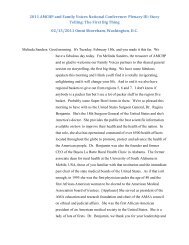


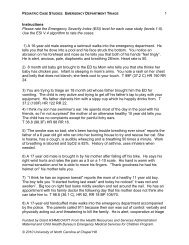
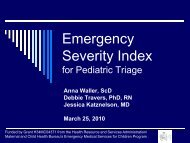
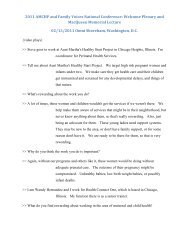
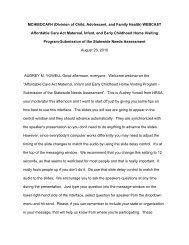
![Hormone Disruptors and Women's Health: Reasons for Concern [PDF]](https://img.yumpu.com/19410002/1/190x245/hormone-disruptors-and-womens-health-reasons-for-concern-pdf.jpg?quality=85)

